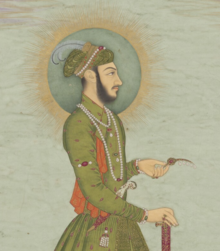
Back محمد اعظم شاه ARZ Məhəmməd Əzəm Şah Azerbaijani محمد اعظم شاه AZB मुहम्मद आजम शाह Bihari মুহাম্মদ আজম শাহ Bengali/Bangla Muhàmmad Azam Xah Catalan محەمەد عەزام شا CKB Muhammad Azam Shah German محمد اعظم شاه Persian मोहम्मद आज़म शाह Hindi
| Azam Shah | |||||
|---|---|---|---|---|---|
| Padishah Al-Sultan Al-Azam | |||||
 Azam Shah holding a turban jewel c. 1675 | |||||
| 7th Mughal Emperor | |||||
| Reign | 14 March 1707 – 20 June 1707 | ||||
| Predecessor | Aurangzeb | ||||
| Successor | Bahadur Shah I | ||||
| 26th Subahdar of Bengal | |||||
| Reign | 1677–1680 | ||||
| Predecessor | Fidai Khan II | ||||
| Successor | Shaista Khan | ||||
| Badshah | Aurangzeb | ||||
| Born | 28 June 1653 Shahi Qila, Burhanpur, Mughal Empire | ||||
| Died | 20 June 1707 (aged 53) Agra Subah, Mughal Empire | ||||
| Burial | Khuldabad, Maharashtra, India | ||||
| Consort | |||||
| Wives | |||||
| Issue |
| ||||
| |||||
| House | House of Babur | ||||
| Dynasty | Timurid dynasty | ||||
| Father | Aurangzeb | ||||
| Mother | Dilras Banu Begum | ||||
| Religion | Sunni Islam (Hanafi) | ||||
| Mughal emperors | ||||||||||||||||||||||||||||||||||||||||||||||
|---|---|---|---|---|---|---|---|---|---|---|---|---|---|---|---|---|---|---|---|---|---|---|---|---|---|---|---|---|---|---|---|---|---|---|---|---|---|---|---|---|---|---|---|---|---|---|
|
||||||||||||||||||||||||||||||||||||||||||||||
Mirza Abu'l Fayaz Qutb-ud-Din Mohammad Azam (28 June 1653 – 20 June 1707), commonly known as Azam Shah, was briefly the seventh Mughal emperor from 14 March to 20 June 1707. He was the third son of the sixth Mughal emperor Aurangzeb and his chief consort Dilras Banu Begum.
Azam was appointed as the heir-apparent (Shahi Ali Jah) to his father on 12 August 1681 and retained that position until Aurangzeb's death.[2] During his long military career, he served as the viceroy of Berar Subah, Malwa, Bengal, Gujarat and the Deccan. Azam ascended the Mughal throne in Ahmednagar upon the death of his father on 14 March 1707. However, he and his three sons, Bidar Bakht, Jawan Bakht and Sikandar Shan, were later defeated and killed by Azam Shah's older half-brother, Shah Alam (later crowned as Bahadur Shah I), during the Battle of Jajau on 20 June 1707.
- ^ Garg, Sanjay (2018). Studies in Indo-Muslim History by S.H. Hodivala Volume II: A Critical Commentary on Elliot and Dowson's History of India as Told by its Own Historians (Vols. V-VIII) & Yule and Burnell's Hobson-Jobson. Routledge. ISBN 9780429757778.
- ^ Sir Jadunath Sarkar (1925). Anecdotes of Aurangzib. M.C. Sarkar & Sons. p. 21.